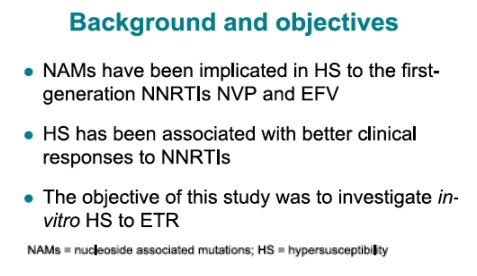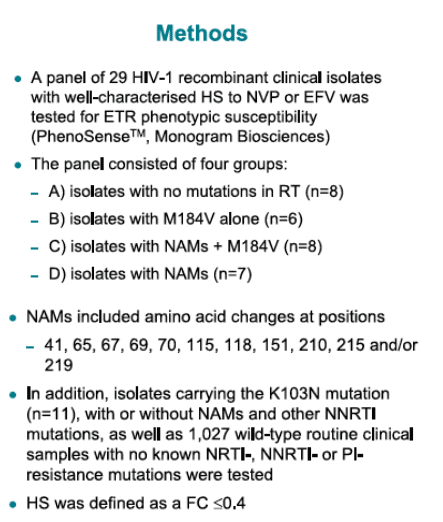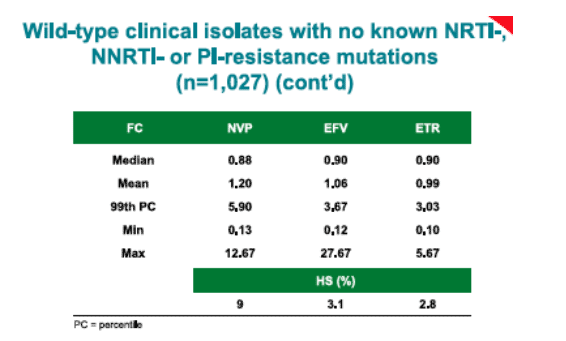 |
 |
 |
| |
Tibotec Analysis: Nucleoside-associated mutations cause hypersusceptibility to etravirine (ETR)
|
| |
| |
Reported by Jules Levin
XVII HIV Drug Resistance Workshop
June 10-14, 200
Sitges, Spain
Gaston Picchio,1 Johan Vingerhoets,2 Neil Parkin,3 Hilde Azijn,2 Marie-Pierre de Bethune2
1Tibotec Inc.,Yardley, PA, USA; 2Tibotec BVBA, Mechelen, Belgium; 3Monogram Biosciences, South San Francisco, CA, USA
Author Conclusions
· HS to ETR was mainly observed among HIV-1 isolates carrying NAMs, M184V, or both
· K103N-containing isolates did not exhibit HS to ETR
- nevertheless, the median (1.18) and individual FC values were below the PhenoSenseTM clinical cut-off for ETR (2.9)1
· The potential impact of HS on response to ETR deserves further investigation
Abstract
Background
Nucleoside associated mutations (NAMs) have been implicated in hypersusceptibility (HS) to first-generation NNRTIs; HS has been associated with better clinical responses to NNRTIs. In-vitro HS to etravirine (ETR; TMC125) was investigated.
Methods
A panel of 29 HIV-1 recombinant clinical isolates with well-characterised HS to nevirapine (NVP) and efavirenz (EFV) was tested for ETR phenotypic susceptibility (PhenoSenseTM, Monogram Biosciences). The panel consisted of four groups: a) isolates with no mutations in reverse transcriptase (RT) (n=8); b) isolates with M184V alone (n=6); c) isolates with NAMs + M184V (n=8); d) isolates with NAMs (n=7). NAMs included amino acid changes at positions: 41, 65, 67, 69, 70, 115, 118, 151, 210, 215, and/or 219. In addition, isolates carrying the K103N mutation (n=11), with or without NAMs and other NNRTI mutations, as well as 1,027 wild-type routine clinical samples with no known NRTI-, NNRTI- or protease inhibitor (PI)-resistance mutations were tested. HS was defined as a fold-change in 50% effective concentration (FC) 20.4.
Results
The proportion of samples with HS to ETR, EFV and NVP, respectively, in each group was: a) 0%, 62.5% and 100%; b) 100%, 100% and 100%; c) 75%, 100% and 87.5%; d) 100%, 71% and 85.7%. Median FC values to ETR, EFV and NVP, respectively, in each group were: a) 0.53, 0.4 and 0.3; b) 0.27, 0.25 and 0.25; c) 0.29, 0.27 and 0.26; d) 0.26, 0.33 and 0.34. In addition, one sample with K103N and NAMs showed HS to ETR (FC=0.24). However, none of 10 samples with K103N alone (n=4) or with K103N + other NNRTI mutations, but no NAMs (n=6)
showed HS to ETR. The median FC among samples with K103N was 1.18 (range 0.49-2.22) for ETR in contrast to 49 for EFV and >100 for NVP. Among wild-type samples, 2.8%, 3.1% and 9.0% showed HS to ETR, EFV, and NVP, respectively.
Conclusions
Among the HIV-1 isolates studied, HS to ETR was mainly observed among those carrying NAMs and/or M184V. K103N-containing isolates did not exhibit HS to ETR; nevertheless, FC values were below the PhenoSenseTM clinical cut-off for ETR (2.9). The potential impact of HS on response to ETR deserves further investigation.






References
1. Coakley, et al. IHDRW 2008, Abstract 122.
|
| |
|
 |
 |
|
|